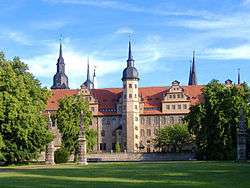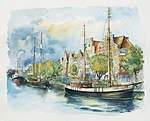Halle (Saale)
| Halle (Saale) | |||
|---|---|---|---|
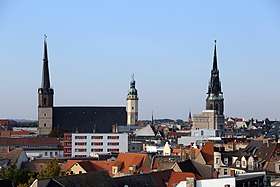 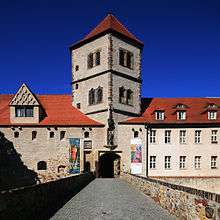   From top: Halle city centre, Moritzburg (Halle), Halle-Neustadt, Francke Foundations and Halle State Museum of Prehistory | |||
| |||
 Halle (Saale) | |||
| Coordinates: 51°29′N 11°58′E / 51.483°N 11.967°ECoordinates: 51°29′N 11°58′E / 51.483°N 11.967°E | |||
| Country | Germany | ||
| State | Saxony-Anhalt | ||
| District | Urban district | ||
| Government | |||
| • Mayor | Bernd Wiegand | ||
| Area | |||
| • Total | 135.01 km2 (52.13 sq mi) | ||
| Elevation | 87 m (285 ft) | ||
| Population (2017-12-31)[1] | |||
| • Total | 239,173 | ||
| • Density | 1,800/km2 (4,600/sq mi) | ||
| Time zone | CET/CEST (UTC+1/+2) | ||
| Postal codes | 06108-06132 | ||
| Dialling codes | 0049345 | ||
| Vehicle registration | HAL | ||
| Website | www.halle.de | ||
Halle (Saale) (UK: /ˈhælə/, US: /ˈhɑːlə/; German: [ˈhalə ˈzaːlə] (![]()
Halle is an economic and educational center in central-eastern Germany. The University of Halle-Wittenberg is the largest university in Saxony-Anhalt, one of the oldest universities in Germany, and a nurturing ground for the local startup ecosystem. Together with Leipzig, Halle is at the heart of the Central German Metropolitan Region.
Geography
Halle (Saale) is in the southern part of Saxony-Anhalt, along the river Saale which drains the surrounding plains and the greater part of the neighbouring Free State of Thuringia just to its south, and the Thuringian basin, northwards from the Thuringian Forest. Leipzig, one of Germany's major cities, is only 35 kilometres (22 mi) away.
History

Name
Halle's early history is connected with the harvesting of salt. The name Halle reflects early Celtic settlement given that halen is the Brythonic (Welsh/Breton) word for salt (cf. salann in Irish). The name of the river Saale also contains the Germanic root for salt, and salt-harvesting has taken place in Halle since at least the Bronze Age (2300–600 BC).
The Latin name Hala Saxonum was also used.[2]
From 1965 to 1995, the official name was Halle/Saale.
Middle Ages until industrialisation
The earliest documented mention of Halle dates from AD 806. It became a part of the Archbishopric of Magdeburg in the 10th century and remained so until 1680, when Brandenburg-Prussia annexed it together with Magdeburg as the Duchy of Magdeburg, while it was an important location for Martin Luther's Reformation in the 16th century. Cardinal Albert of Mainz (Archbishop of Magdeburg from 1513 to 1545) also impacted on the town in this period. According to historic documents, the city of Halle became a member of the Hanseatic League at least as early as 1281.
Halle became a center for Pietism, a movement encouraged by King Frederick William I of Prussia (reigned 1713-1740) because it caused the area's large Lutheran population to be more inclined to Fredrick William I's religion (Calvinism), as well as more loyal to the Prussian king instead of to the decentralized feudal system. By the 1740s Halle had established many orphanages as well as schools for the wealthy in the sober style Pietism encouraged. This Halle education was the first time the "modern education" system was established. The Halle Pietists also combated poverty.[3]
During the War of the Fourth Coalition, French and Prussian forces clashed in the Battle of Halle on 17 October 1806. The fighting moved from the covered bridges on the city's west side, through the streets and market place, to the eastern suburbs.
In 1815 Halle became part of the Prussian Province of Saxony.
World War II (1939–1945)
During World War II, KZ-Außenlager Birkhahn, a subcamp of Buchenwald was in Halle, where prisoners from Poland, Czechoslovakia, the Soviet Union, France, Netherlands and other nations[4] were forced to work in the Siebel aircraft plants, making combat aircraft. The plant was later dismantled. In Ammendorf, a large factory owned by Orgacid produced mustard gas.
Near the end of World War II, there were two bombing raids carried out against the town: the first on 31 March 1945, the second a few days later. The first attack took place between the railway station and the city's centre, and the second bombing was in the southern district. It killed over 1,000 inhabitants and destroyed 3,600 buildings. Among them, the Market Church, St. George Church, the Old Town Hall, the City Theatre, historic buildings on Bruederstrasse and on Grosse Steinstrasse, and the city cemetery.
On 17 April 1945, American soldiers occupied Halle, and the red tower was set on fire by artillery and destroyed. The Market Church and the Church of St. George received more hits. However, the city was spared further damage because an aerial bombardment was canceled, after former naval officer Felix von Luckner negotiated the city's surrender to the American army. In July, the Americans withdrew and the city was occupied by the Red Army.
German Democratic Republic (1949–1990)
After World War II, Halle served as the capital of the short-lived administrative region of Saxony-Anhalt until 1952, when the East German government abolished its "Länder" (states). As a part of East Germany (until 1990), it functioned as the capital of the administrative district (Bezirk) of Halle.
Since German unity (after 1990)
When Saxony-Anhalt was re-established as a Bundesland in 1990, Magdeburg, not Halle, became the capital.
Largest groups of foreign residents by 31.12.2017
| 6,350 | |
| 1,585 | |
| 915 | |
| 905 | |
| 860 | |
Sights

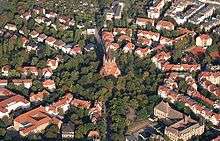
- Halloren Chocolate Factory and visitors' centre, Germany's oldest chocolate factory still in use.[5]
- Giebichenstein Castle, first mentioned in 961, is north of the city centre on a hill above the Saale river, with a museum in the upper castle and the Burg Giebichenstein University of Art and Design in the lower castle.
- Moritzburg, a newer castle, was built between 1484 and 1503. It was the residence of the Archbishops of Magdeburg, was destroyed in the Thirty Years' War, and was a ruin for centuries afterward. Partially reconstructed in 1901-1913, it is an art gallery today. The reconstruction was completed with the opening of new exhibition rooms designed by the Spanish architects Sobejano and Nieto in 2010.
- Neue Residenz (New Residence), an early Renaissance palace (1531–1537)
- Market square with
- Market Church of St. Mary (Marktkirche), built in 1529–1554, using elements of two medieval churches, St. Gertrude's Church dating back to the 11th century and the older St. Mary's Church from the 12th century. The church has four steeples, the two western octagonal ones are called Blue Towers because of their dark blue slate roofing. The other two Hausmannstürme are connected by a bridge and on this bridge was the city's fire watch. The church owns the original death-mask of Martin Luther. The Marktkirche's four towers is a landmark symbol of the city.[6][7]
- Roter Turm (Red Tower), originally built as campanile of the older St. Mary's Church between 1418 and 1503, a landmark of Halle, with the steeples of St. Mary's Church forms the five towers marking the city’s skyline.
- Roland, originally (13th century) a wooden sculpture representing urban liberty (after an uprising in the city, a cage was placed around it between 1481 and 1513, a reminder of the restrictions). Today’s sculpture is a sandstone replica made in 1719.
- Marktschlösschen, late Renaissance building, gallery and tourist information office
- Monument to George Frideric Handel, 1859 by Hermann Heidel
- Ratshof (Council’s Yard), built in 1928/29 as a backyard building of the Old Town Hall (demolished in 1948/50 after the destruction of World War II, so the Ratshof is situated today directly on the market square).
- Stadthaus, Renaissance-Revival building of 1891-1894
- Yellow line, which runs over the market square, marking a geological fault line, the Hallische Verwerfung.
- Handel House, first mentioned in 1558, birthplace of George Frideric Handel, a museum since 1948
- Old Market square with Donkey's Fountain (1906/13), referring to a local legend
- Remains of the town fortifications: the Leipzig Tower (Leipziger Turm) (15th century) in the east and remains of the town wall to the south of the city centre.
- Francke Foundations, Baroque buildings (including Europe's largest surviving half-timbered building) and historical collections
- Stadtgottesacker, a Renaissance cemetery, laid out in 1557, in the style of an Italian camposanto
- Saline Museum is dedicated to Halle’s salt-works and the corporation of salt workers (Halloren)
- Cathedral (Dom), a steepleless building, was originally a church within a Dominican monastery (1271), converted into a cathedral by cardinal Albert of Hohenzollern. Since 1688, it has been the church of the Reformed parish.
- Saint Maurice Church, late Gothic building (1388–1511)
- Saint Ulrich Church, late Gothic church of the Servite Order (15th century), today used as a concert hall
- Church of the former village of Böllberg (Romanesque, with late Gothic painted wooden ceiling)
- Numerous bourgeois town houses, including the Ackerbürgerhof (15th – 18th centuries with remains from the 12th century), Christian Wolff’s House (today City Museum), Graseweg House (half-timbered building)
- State Museum of Prehistory where the Nebra sky disk is exhibited
- Volkspark (1906/07), former meeting house of the Social Democrats
- Theatres:
- Halle Opera House
- Neues Theater
- Puppentheather
- Thalia Theater, the only theatre for children in Saxony-Anhalt
- Steintor Bühne
- Parks and gardens:
- Botanical Garden of the Martin Luther University of Halle-Wittenberg, founded in 1698 in the former gardens of the Archbishops of Magdeburg, belonging to the Garden Dreams project
- Reichardts Garten is a historic park, part of the Garden Dreams project. Laid out in 1794 by Johann Friedrich Reichardt (1752–1814) as an English garden, becoming the "accommodation of Romanticism". It changed ownership several times and the city of Halle bought the park in 1903 to give the public wider access.
- Peißnitz Island
- Pestalozzi Park
- Zoological Garden (Bergzoo), situated on the Reilsberg hill.
- Galgenberge, location of the gallows from the 14th to the end of the 18th century
- Klausberge, porphyry hill, named after a chapel of the St. Nicholas' brotherhood, panoramic view over the Saale Valley, Eichendorff's bench
- Dölauer Heide forest, including Bischofs Wiese with 35 graves dating back to about 2500–2000 BC, the Neolithic period
- Racecourse in the Passendorf Meadows
- Halle-Neustadt, to the west of Halle, built beginning 1964 (foundation stone ceremony 15 July 1964) as a socialist model city.
Industrial heritage
Salt, also known as white gold, was extracted from four "Borns" (well-like structures). The four Borns/brine named Gutjahrbrunnen, Meteritzbrunnen, Deutscher Born and Hackeborn, were located around the Hallmarket (or "Under Market"), now a market square with a fountain, just across from the TV station, MDR. The brine was highly concentrated and boiled in Koten, simple structured houses made from reed and clay. Salters, who wore a unique uniform with eighteen silver buttons, were known as Halloren, and this name was later used for the chocolates in the shape of these buttons.
The Halloren-Werke, the oldest chocolate factory in Germany, was founded in 1804. Old documents are on display and a chocolate room can be visited.
Within East Germany, Halle's chemical industry, now mainly shut down, was of great importance. The two main companies in the region were Buna-Werke and Leuna, and Halle-Neustadt was built in the 1960s to accommodate the employees of these two factories.
Science and culture
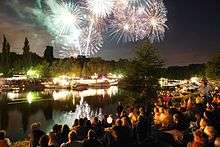
Baroque composer Georg Friedrich Händel (later George Frideric Handel) was born in Halle in 1685 and spent the first 17 years of his life in the city. The house where he lived is now a museum about his life. To celebrate his music, Halle has staged a Handel Festival since 1922, annually in June since 1952. The Franckesche Stiftungen (Francke Foundations) are home to the Stadtsingechor zu Halle, which was founded before the year 1116 and is one of the oldest boys' choirs in the world.
The University of Halle was founded here in 1694. It is now combined with the University of Wittenberg and called the Martin Luther University of Halle-Wittenberg. The university's medical school was established by Friedrich Hoffmann. Its botanical garden, the Botanische Garten der Martin-Luther-Universität Halle-Wittenberg, dates back to 1698. Halle's German Academy of Sciences Leopoldina is the oldest and one of the most respected scientific societies in Germany. Halle is also home to Germany's oldest Evangelical Bible college, known as the Marienbibliothek, with 27,000 titles. The seat of the Max Planck Institute for Social Anthropology, one of the world's largest social anthropological research institutions and a part of the Max Planck Society, is in Halle.
Halle was a centre of German Pietism and played an important role in establishing the Lutheran church in North America, when Henry Muhlenberg and others were sent as missionaries to Pennsylvania in the mid-18th century. Muhlenberg is now called the first Patriarch of the Lutheran Church in America. He and his son, Frederick Muhlenberg, who was the first Speaker of the United States House of Representatives, were graduates of Halle University.
The Silver Treasure of the Halloren is displayed occasionally at the Technical Museum Saline. It is a unique collection of silver and gold goblets dating back to 1266. The ancient craft of "Schausieden" (boiling of the brine) can be observed there too. The State Museum of Prehistory houses the Nebra sky disk, a significant (though unproven) Bronze-Age find with astrological significance.
Halle Zoo contributes to the EAZA breeding programme, in particular for the Angolan lion and the Malaysian tiger. Halle is also known for its thriving coypu (or nutria) population, which is native to South America.
With writers such as Heine, Eichendorff, Schleiermacher, Tieck and Novalis the town was a vibrant scene of the German Romanticism. Also Johann Wolfgang von Goethe was a regular guest at the house of his close friend Johann Friedrich Reichardt.
German-American expressionist painter Lyonel Feininger worked in Halle on an invitation by the city from 1929 to 1931. As one of eleven views of the city termed Halle Cycle, he painted in 1931 Die Türme über der Stadt[8] (The towers above the city), which is now in the Museum Ludwig in Cologne.[9] This painting appeared on a 55 eurocent stamp on 5 December 2002 as a part of the series “Deutsche Malerei des 20. Jahrhunderts” (German painting of the 20th century).[10]
Transport history
Ludwig Wucherer made Halle an important rail hub in central Germany. In 1840 he opened the Magdeburg-Halle-Leipzig line, completing a connection between Magdeburg and Dresden. In 1841–1860, other lines to Erfurt, Kassel and Berlin followed.
The centrepiece of Halle's urban public transport system is the Halle (Saale) tramway network. It includes the world's first major electric-powered inner-city tram line, which was opened in 1891.[11] Halle (Saale) Hauptbahnhof is the main railway station.
Halle's prominence as a railway centre is set to continue growing with the arrival of the Erfurt-Leipzig/Halle high-speed railway. Leipzig will also be connected to this railway, but since it is a terminus station (though the Leipzig City Tunnel is currently under construction, the route will be shared with S-Bahn trains, making it unlikely that it will be used as a through station for Berlin-Munich trains), Halle is more likely to be used as an intermediate stop for Berlin-Munich trains. The completion of the Nuremberg–Erfurt high-speed railway will also provide a further impetus to use the route.
Sports
The football team Hallescher FC Wacker 1900 had some regional importance before World War II. In the German Championship Wacker reached the semi-finals in 1921, and the quarter-finals in 1928. The successor team became East German champions in 1949 and 1952 under the names of ZSG Union and BSG Turbine Halle. From these evolved today's Turbine Halle and Hallescher FC. In the era of the German Democratic Republic, the latter club (as Chemie Halle ) was a mainstay in the first division and won the Cup tournament in 1956 and 1962. The most prominent player was 72-times international Bernd Bransch, who was with Chemie in the 1960s and 1970s. These days, Hallescher FC usually plays in the third division.
The general sports club SV Halle, originating from Chemie Halle, created a notable number of Olympic gold medallists and world champions, mainly in nautical and watersports, e.g., swimmer Kornelia Ender won four Olympic gold medals in 1976 and Andreas Hajek won four rowing world championships between 1998 and 2001. The basketball team of the club - these days known as Lions and focusing on the woman's team which plays in the national first division - won five men's and 10 women's championships of the German Democratic Republic. The Hallesher FC's location is extremely close to a train station.
Notable residents
A–K
- Anne Catherine of Brandenburg, (1575–1612) in Copenhagen, Queen of Denmark and Norway (1597–1612)
- Bernd Baselt (1934–1993), university professor whose published catalogue led to the modern day opus designator (HWV) which is now commonly used when referring to the works of George Frideric Handel.
- Oswald Boelcke (1891–1916), World War I German flying ace, born near Halle.
- Georg Cantor (1845–1918), mathematician and professor at the university of Halle.
- Waldemar Cierpinski, East German athlete and two times Olympic Champion, lives in Halle.
- Walter Eisfeld (1905–1940), Nazi SS concentration camp commandant
- Dorothea Christiane Erxleben of Quedlinburg (1715–1762) received her Doctor of Medicine degree in 1754 from the Medical Department of Martin Luther University (MLU).
- Gerhard Feige, (born 1951), bishop of Magdeburg
- Lyonel Feininger (1871–1956), painter who created several famous images in Halle, including Der Dom in Halle.
- August Hermann Francke (1663–1727), Lutheran Pietist theologian at the University of Halle and founder of the internationally renowned Halle Orphan House complex.
- Hans-Dietrich Genscher (1927–2016), a former Vice Chancellor and longest serving Foreign Minister of Germany, was born in Reideburg, which belongs to Halle today.
- Moritz Goetze (born 1964), pop-artist, painter, sculptor, born and lives in Halle
- Paul Götze (1903–1948), Nazi SS officer at Auschwitz and Buchenwald concentration camps executed for war crimes
- Siegwart Horst Günther (1925-2015) The 'father of the anti-uranium-weapons movement in Germany',[12] born in Halle
- Georg Friedrich Händel (1685–1759), Baroque composer, was born and raised in Halle.
- Johannes Hassebroek (1910–1977), Nazi SS commandant of Gross-Rosen concentration camp was born in the city.
- Carola Helbing-Erben, textile artist
- Yoan Pablo Hernández, Cruiserweight boxing champion (immigrated from Cuba).
- Reinhard Heydrich (1904–1942), one of the leading Nazis in World War II and main architects of the Holocaust
- Nickel Hoffmann, mastermason, worked over 30 years in Halle, including the Market Church and the Composanto.
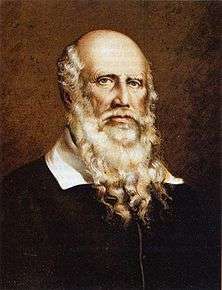
- Friedrich Ludwig Jahn (1778–1852), theology student of University Halle 1796–1800, went into hiding and used a phorphyr cave along the river Saale at the Klausberge, this cave later was known as the "Jahn-Höhle" (Cave), not just known for his four F as in "frisch, fromm, fröhlich, frei" (fresh, pious, happy and free).
- Christian Knaut, (1656–1716), doctor, botanist and librarian
- Manfred Kuschmann, East German athlete and European Champion of 1974 lived in Halle.
L–Z
- August Lafontaine (1758–1831), a writer of sentimental novels hugely popular in their time, died in Halle.
- Blessed Carl Lampert, priest, beheaded by Nazis in World War II at Halle.
- Marita Lange (born 1943), athlete
- Georg Listing (born 1987), bassist from the Magdeburg-based band, Tokio Hotel.
- Hans Litten (1903–1938), German lawyer who represented opponents of the Nazis at important political trials between 1929-1932.
- Frederick Muhlenberg (1750–1801), the first Speaker of the United States House of Representatives, graduated at Halle University.
- George Müller (1805–1898), coordinator of orphanages in Bristol, England.
- Johann Friedrich Naue (1787–1858), classical composer
- Kai Pflaume (born 1967), German television presenter, born in Halle.
- Richard Raatzsch (born 1957), philosopher and professor of practical philosophy
- Johann Friedrich Reichardt (1752–1814), composer, writer and music critic, lived in Halle. He was a close friend of Johann Wolfgang von Goethe.
- Samuel Scheidt (1587–1654), early Baroque composer and organist was both born and spent the majority of his life and career in Halle.
- Fabian von Schlabrendorff (1907–1980), lawyer, officer, judge and member of the German resistance.
- Friedrich Daniel Ernst Schleiermacher (1768–1834), university preacher and professor of theology to the University of Halle, where he remained until 1807.
- Albrecht Schröter (born 1955), politician (SPD) and mayor of Jena
- Ullrich Sierau (born 1956), politician (SPD) and mayor of Dortmund

- Leonhard Sohncke (1842–1897), in Munich, mathematician and professor of physics
- Georg Wilhelm Steller (1709–1746), a botanist, zoologist, physician and explorer of Siberia, Kamchatka and Alaska.
- Hans-Christian Ströbele (born 1939), politician (Greens) and member of the Bundestag
- Ľudovít Štúr (1815–1856), Slovak national leader, linguist and writer, studied at the University of Halle in 1838–1840.
- Daniel Gottlob Türk (1756–1813), classical composer, was born in Halle in 1750, and was a professor at the University of Halle.
- Andreas Wank (born 1988), German ski jumper, born in Halle.
- Ludwig Wucherer (1790–1861), elected councillor.
- Rudolf Ernst Weise (1844-1935), engineer, entrepreneur and industrialist.[13]
International relations
|
Furthermore, Halle has friendship agreements with:[14]


Around Halle
Nearby towns
Halle (Saale) and Leipzig are the two centres of the Central German Metropolitan Region with more than 2.4 million people.
References
- ↑ "Bevölkerung der Gemeinden – Stand: 31. Dezember 2017" (PDF). Statistisches Landesamt Sachsen-Anhalt (in German).
- ↑ Lexicum nominum geographicorum latinorum
- ↑ Clark, Christopher (2007). Iron Kingdom: The Rise and Downfall of Prussia, 1600-1947. Penguin UK. ISBN 9780141904023. Retrieved 2017-05-18.
In Halle, too, the local Pietists battled poverty and indigence. Around the charismatic figure of August Hermann Francke there was an extraordinary flowering of Christian voluntarism. In 1695, Francke opened a poor-school financed by pious donations.
- ↑ Das vergessene Lager: Eine Dokumentation zum Außenkommando des KZ Buchenwald in Halle/Saale 1944/45
- ↑ Oliver Nieburg: Katjes International ups stake in chocolate maker Halloren Confectionery News, 18 November 2016. Accessed 6 March 2017
- ↑ "Marktkirche "Unser Lieben Frauen"" (in German). Halle Saale. Archived from the original on 17 March 2012. Retrieved 1 January 2012.
- ↑ "Halle – The City of Five Towers Between the Past and Present". Deutsche Welle. Retrieved 1 January 2012.
- ↑ "Painting". ids.lib.harvard.edu.
- ↑ "Halle – A City of Five Towers Between the Past and Present". Deutsche Welle. Retrieved 1 January 2012.
- ↑ "Auswahl Neuausgaben 2002" (in German). Junghans Gruppe. Archived from the original on August 25, 2010. Retrieved 1 January 2012.
- ↑ Wolfgang König, Wolfhard Weber: Netzwerke. Stahl und Strom. 1840 bis 1914. In: Propyläen Technikgeschichte. Bd. 4, Propyläen Verlag, Berlin 1991–1992, ISBN 3-549-07113-2, page 344
- ↑ Germany, ICBUW. "Prof. Siegwart-Horst Günther - 1925 - †2015". www.bandepleteduranium.org. Retrieved 2017-10-30.
- ↑ https://www.buergerstiftung-halle.de/bildung-im-voruebergehen/weise/
- 1 2 "Halle (Saale) - Händelstadt: Towns twinned with Halle (Saale)". Retrieved 2014-07-19.
- ↑ "Ystävyyskaupungit (Twin Cities)". Oulun kaupunki (City of Oulu) (in Finnish). Retrieved 27 July 2013.
- ↑ Jérôme Steffenino, Marguerite Masson. "Ville de Grenoble –Coopérations et villes jumelles". Grenoble.fr. Retrieved 16 May 2013.
- ↑ "Städtepartnerschaften" (in German). Stadt Karlsruhe. 16 December 2010. Archived from the original on 24 July 2010. Retrieved 5 January 2011.
Bibliography
- See also: Bibliography of the history of Halle
External links
| Wikimedia Commons has media related to Halle (Saale). |
| Wikivoyage has a travel guide for Halle. |
.svg.png)
.svg.png)
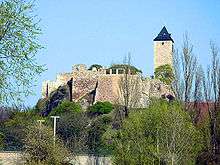
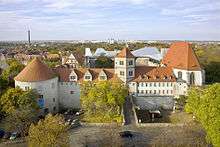


.jpg)


